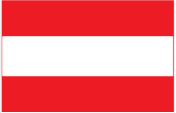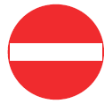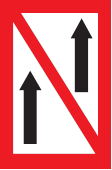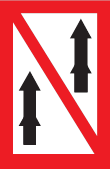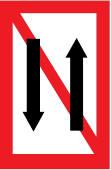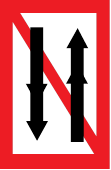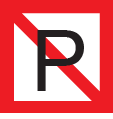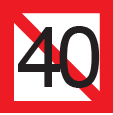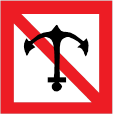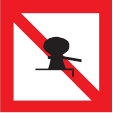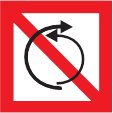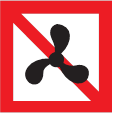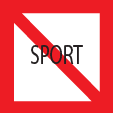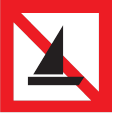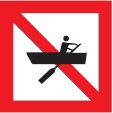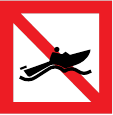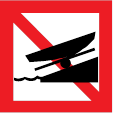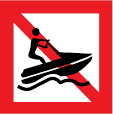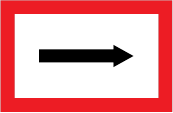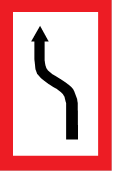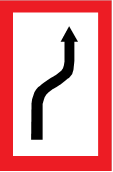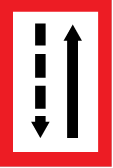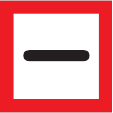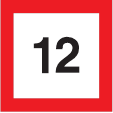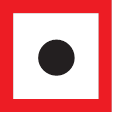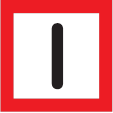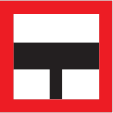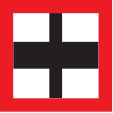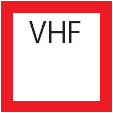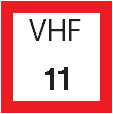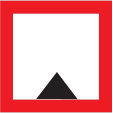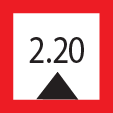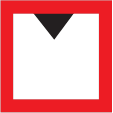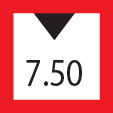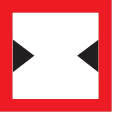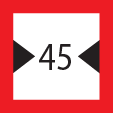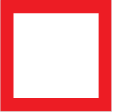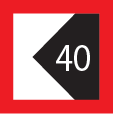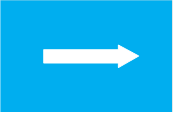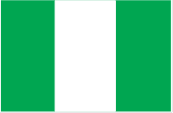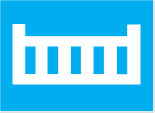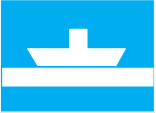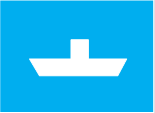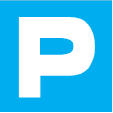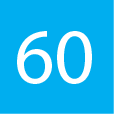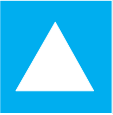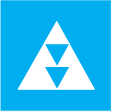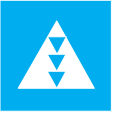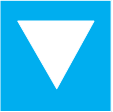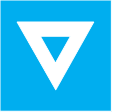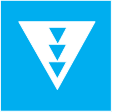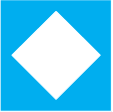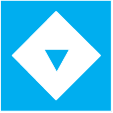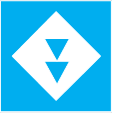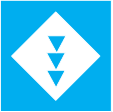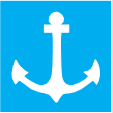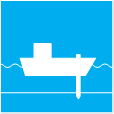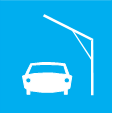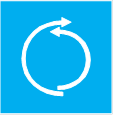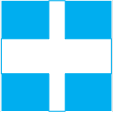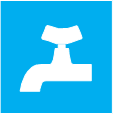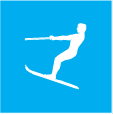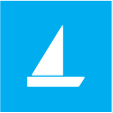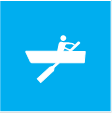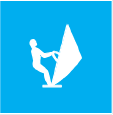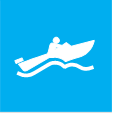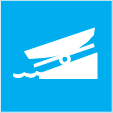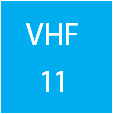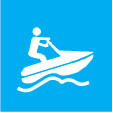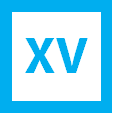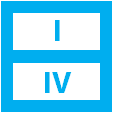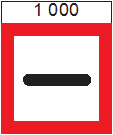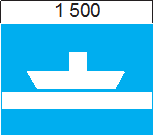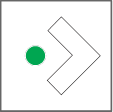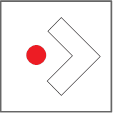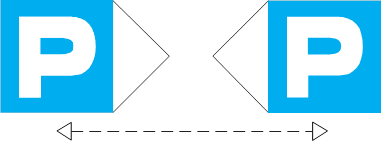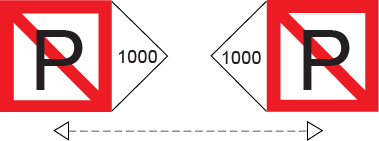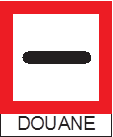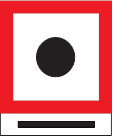Français | ???
|
1) Les signaux principaux figurant à la section I ci-dessous peuvent être complétés ou explicités par des signaux auxiliaires figurant à la section II.
2) Les panneaux peuvent, pour être mieux visibles, comporter un mince filet blanc suivant leur contour extérieur.
I. Signaux principaux
A. Signaux d'interdiction
A.1 | Interdiction de passer (signal général) (voir articles 3.25 paragraphe 2b), 6.08, 6.16, 6.22, 6.22 bis, 6.25, 6.26, 6.27 et 6.28 bis) | A.1a panneaux | |||
| A.1b, A.1c et A.1d soit feux rouges | ou | ou | |||
Deux panneaux, deux feux ou deux pavillons superposés indiquent une interdiction prolongée | A.1e et A.1f soit pavillons rouges | ou | |||
A.1.1 | Sections désaffectées, interdiction de naviguer, à l’exception des menues embarcations non motorisées (voir article 6.22, par.2) | A.1g |
A.2 | Interdiction de tout dépassement (voir article 6.11, a)) |
A.3 | Interdiction de dépasser entre convois seulement (voir article 6.11, b)) |
A.4 | Interdiction de croiser et de dépasser (voir article 6.08, par.1) |
A.4.1 | Interdiction de stationner du côté de la voie où le panneau est placé (c'est-à-dire d'ancrer ou de s'amarrer à la rive) (voir article 7.02, par.1) |
A.5 | Interdiction de stationner sur le plan d'eau dont la largeur, comptée à partir du panneau, est indiquée en mètres sur celui-ci (voir article 7.02, par.1) |
A.5.1 | No berthing on the stretch of water whose breadth, measured from the sign, is shown in metres on the sign (see article 7.02, para. 1) |
A.6 | Interdiction d'ancrer et de laisser traîner les ancres, câbles ou chaînes du côté de la voie où le panneau est placé (voir articles 6.18, par.2 and 7.03, par.1b)) |
A.7 | Interdiction de s'amarrer à la rive du côté où le panneau est placé (voir article 7.04, par. 1 b)) |
A.8 | Interdiction de virer (voir article 6.13, par. 5) |
A.9 | Interdiction de créer des remous pouvant causer des dommages (voir article 6.20, par. 1 (e)) | ||
A.9a | |||
A.9b | |||
A.10 | Interdiction de passer en dehors de l'espace indiqué (dans une ouverture de pont ou de barrage) (voir article 6.24, par. 2 a)) |
A.11 | Interdiction de passer, mais préparez-vous à vous mettre en marche (voir articles 6.26 et 6.28 bis) | ||
A.11a | |||
ou | |||
A.11b | |||
ou | |||
A.11c (feu rouge éteint) | |||
A.12 | Navigation interdite aux bateaux motorisés |
A.13 | Navigation interdite aux embarcations de sport ou de plaisance | |
A.14 | Pratique du ski nautique interdite |
A.15 | Navigation interdite aux bateaux à voile |
A.16 | Navigation interdite aux bateaux qui ne sont ni motorisés ni à voile |
A.17 | Pratique de la planche à voile interdite |
A.18 | Fin de la zone autorisée pour la navigation à grande vitesse des menues embarcations de sport ou de plaisance |
A.19 | Interdiction de mettre des embarcations à l'eau ou de les en retirer |
A.20 | Motos nautiques interdites |
B. Signaux d'obligation
B.1 | Obligation de suivre la direction indiquée par la flèche (voir article 6.12, par. 1) |
B.2 | ||
B.2a Obligation de se diriger vers le côté du chenal situé à bâbord (voir article 6.12, par. 1) | ||
B.2b Obligation de se diriger vers le côté du chenal situé à tribord (voir article 6.12, par. 1) | ||
B.3 | ||
B.3a Obligation de tenir le côté du chenal situé à bâbord (voir article 6.12, par. 1) | ||
B.3b Obligation de tenir le côté du chenal situé à tribord (voir article 6.12, par. 1) | ||
B.4 | ||
B.4a Cross fairway to port (see article 6.12, para. 1) | ||
B.4b Cross fairway to starboard (see article 6.12, para. 1) | ||
B.5 | Stop as prescribed in the Regulations (see articles 6.26, para. 2 and 6.28, para. 1) |
B.6 | Do not exceed the speed indicated (in km/h) |
B.7 | Give a sound signal |
B.8 | Keep a particularly sharp lookout (see article 6.08, para. 2) |
B.9 | Do not enter or cross the main waterway until certain that this will not oblige vessels proceeding on it to change their course or speed (see article 6.16, para. 4) | ||
B.9a | |||
B.9b | |||
B.10 | Vessels proceeding on the main waterway must, if necessary, change course and speed to allow vessels to leave harbours or tributary waterways (see article 6.16, paras 3 and 6) |
B.11 | |||
B.11a Obligation to enter into a radiotelephone link (see article 4.05, para. 5) | |||
B.11b Obligation to enter into a radiotelephone link on the channel as indicated on the board (see article 4.05, para. 5) | |||
C. RESTRICTIVE SIGNS
C.1 | Depth of water limited | C.1a | C.1b |
C.2 | Headroom limited | C.2a | C.2b |
C.3 | Width of passage or channel limited | C.3a | C3b |
Note: | Boards C.1, C.2 and C.3 may carry, in addition, figures indicating in metres the depth of water, the headroom and the width of passage or the channel respectively |
C.4 | There are restrictions on navigation: see the information plate below the sign |
C.5 | The channel lies at a distance from the right (left) bank; the figure shown on the sign indicates the distance in metres, measured from the sign, to which vessels should keep |
D. RECOMMENDATORY SIGNS
D.1 | Recommended opening | |||
(a) In both directions (see articles 6.25, 6.26 and 6.27) | D.1a | or | D.1b | |
(b) Only in the direction indicated (passage in the opposite direction proehibited) (see articles 6.25, 6.26 and 6.27) | D.1c | or | e D.1d | |
D.1e | or | e D.1f | ||
D.2 | You are recommended to keep within the area indicated (in openings of bridges or weirs) (see article 6.24, para. 2 (b)) | |
D.2a | ||
or | ||
D.2b | ||
D.3 | You are recommended to proceed: | |
D.3a In the direction shown by the arrow | ||
or | ||
D.3b In the direction from the fixed light towards the isophase light | ||
E. INFORMATIVE SIGNS
E.1 | Entry permitted (general sign) (see articles 6.08, 6.16, 6.26, 6.27 and 6.28 bis) | |||||
E.1a | ||||||
or | ||||||
E.1b, E.1c and E.1d | or | or | ||||
E.2 | Overhead cable crossing |
E.3 | Weir |
E.4 | ||
E.4a Ferry-boat not moving independently | ||
E.4b Ferry-boat moving independently | ||
E.5 | Berthing (i.e. anchoring or making fast to the bank) permitted on the side of the waterway on which the sign is placed (see articles 7.02, para. 2 and 7.05, para. 1) |
E.5.1 | Berthing permitted on the stretch of water of the breadth measured from, and shown on the board in metres (see article 7.05, para. 2) |
E.5.2 | Berthing permitted on the stretch of water bounded by the two distances measured from, and shown on the board in metres (see article 7.05, para. 3) |
E.5.3 | Maximum number of vessels permitted to berth abreast on the side of the waterway on which the sign is placed (see article 7.05, para. 4) |
E.5.4 | Berthing area reserved for pushing-navigation vessels that are not required to carry the marking prescribed in article 3.14 on the side of the waterway on which the sign is placed (see article 7.06) |
E.5.5 | Berthing area reserved for pushing-navigation vessels that are required to carry one blue light or one blue cone under article 3.14, paragraph 1, on the side of the waterway on which the sign is placed (see article 7.06) |
E.5.6 | Berthing area reserved for pushing-navigation vessels that are required to carry two blue lights or two blue cones under article 3.14, paragraph 2, on the side of the waterway on which the sign is placed (see article 7.06) |
E.5.7 | Berthing area reserved for pushing-navigation vessels that are required to carry three blue lights or three blue cones under article 3.14, paragraph 3, on the side of the waterway on which the sign is placed (see article 7.06) |
E.5.8 | Berthing area reserved for vessels other than pushing-navigation vessels that are not required to carry the marking prescribed in article 3.14 on the side of the waterway on which the sign is placed (see article 7.06) |
E.5.9 | Berthing area reserved for vessels other than pushing-navigation vessels that are required to carry one blue light or one blue cone under article 3.14, paragraph 1, on the side of the waterway on which the sign is placed |
E.5.10 | Berthing area reserved for vessels other than pushing-navigation vessels that are required to carry two blue lights or two blue cones under article 3.14, paragraph 2, on the side of the waterway on which the sign is placed (see article 7.06) |
E.5.11 | Berthing area reserved for vessels other than pushing-navigation vessels that are required to carry three blue lights or three blue cones under article 3.14, paragraph 3, on the side of the waterway on which the sign is placed |
E.5.12 | Berthing area reserved for all vessels that are not required to carry the marking prescribed in article 3.14, on the side of the waterway on which the sign is placed (see article 7.06) |
E.5.13 | Berthing area reserved for all vessels that are required to carry one blue light or one blue cone under article 3.14, paragraph 1, on the side of the waterway on which the sign is placed (see article 7.06) |
E.5.14 | Berthing area reserved for all vessels that are required to carry two blue lights or two blue cones under article 3.14, paragraph 2 |
E.5.15 | Berthing area reserved for all vessels that are required to carry three blue lights or three blue cones under article 3.14, paragraph 3, on the side of the waterway on which the sign is placed (see article 7.06) |
E.6 | Anchoring (see article 7.03, para. 2) or trailing of anchors, cables or chains permitted on the side of the waterway on which the sign is placed. (see article 6.18, para. 3) |
E.6.1 | Use of spuds permitted (see article 7.03) |
E.7 | Making fast to the bank permitted on the side of the waterway on which the sign is placed (see article 7.04, para. 2) |
E.7.1 | Berthing area reserved for loading and unloading vehicles. (Maximum duration of berthing permitted may be added on an information plate below the board) |
E.8 | Turning area (see articles 6.13, para. 5 and 7.02 para. 1 (i)) |
E.9 | The waterways being approached are considered to be tributaries of this waterway (see article 6.16, para. 1) | |
E.9.a | ||
E.9.b | ||
E.9.c | ||
E.10 | This waterway is considered to be a tributary of the waterway being approached (see article 6.16, para. 1) | |
E.10a | ||
E.10b | ||
E.11 | End of a prohibition or obligation applying to traffic in one direction only, or end of a restriction | |
E.11a | ||
or | ||
E.11b | ||
E.12 | Advance signals: one or two white lights | ||||
(a) Fixed light(s): Difficulty ahead – stop if the regulations so require | E.12a | or | E12.b | ||
(b) Isophase light(s): You may proceed | E12.c | or | E.12d | ||
E.13 | Drinking-water supply |
E.14 | Telephone |
E.15 | Motorized vessels permitted |
E.16 | Sports or pleasure craft permitted [1] |
E.17 | Water skiing permitted |
E.18 | Sailing vessels permitted |
E.19 | Craft other than motorized vessels or sailing craft permitted |
E.20 | Use of sailboards permitted |
E.21 | Zone authorized for high speed navigation of small sport and pleasure craft |
E.22 | Launching or beaching of small craft permitted |
E.23 | Possibility of obtaining nautical information by radio-telephone on the channel indicated |
E.24 | Water bikes permitted |
E.25 | Electrical power supply point |
E.26 | Winter harbour |
E.26.1 | Maximum number of vessels permitted to berth in winter harbour |
E.27 | Winter shelter |
E.27.1 | Maximum number of vessels permitted to berth in winter shelter Maximum number of vessels permitted to berth abreast Maximum number of rows of vessels which are berthed abreast |
II. AUXILIARY SIGNS
The main signs (see section I) may be supplemented by the following auxiliary signs:
1. Panels showing the distance at which the regulation applies or the special feature indicated by the main sign is to be found
Note: The panels are placed above the main sign.
Examples : | In 1,000 m, stop | In 1,500 m, ferry-boat not moving independently |
2. Additional luminous signal
Luminous white arrow combined with certain lights, with the following meanings:
(a) With green light Example: Permission to enter the basin to which the arrow is pointing | ||
(b) With red light Example: No entry to the basin to which the arrow is pointing |
3. Pointers showing the direction of the section to which the main sign applies
Note: The pointers need not necessarily be white and may be placed beside or below the main sign.
Examples : | Berthing permitted |
Berthing prohibited (over a distance of 1,000 m) |
4. Panels giving explanations or additional information
Note: These panels are placed below the main sign.
Examples : | ||
Stop for Customs | Give one long blast |
[1] The competent authorities may also use this board to permit small craft.
signaux d'interdiction
signaux d'obligation
